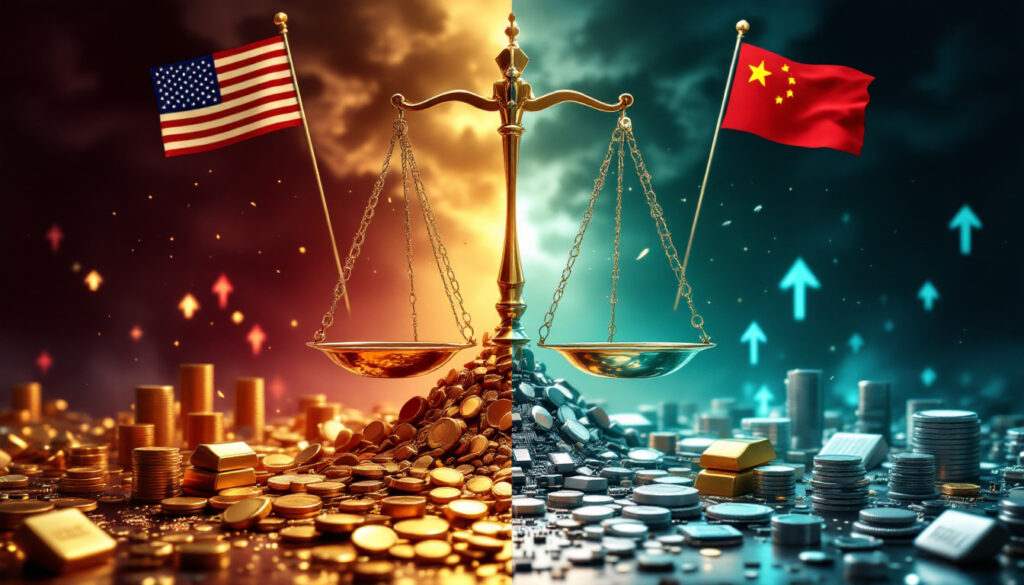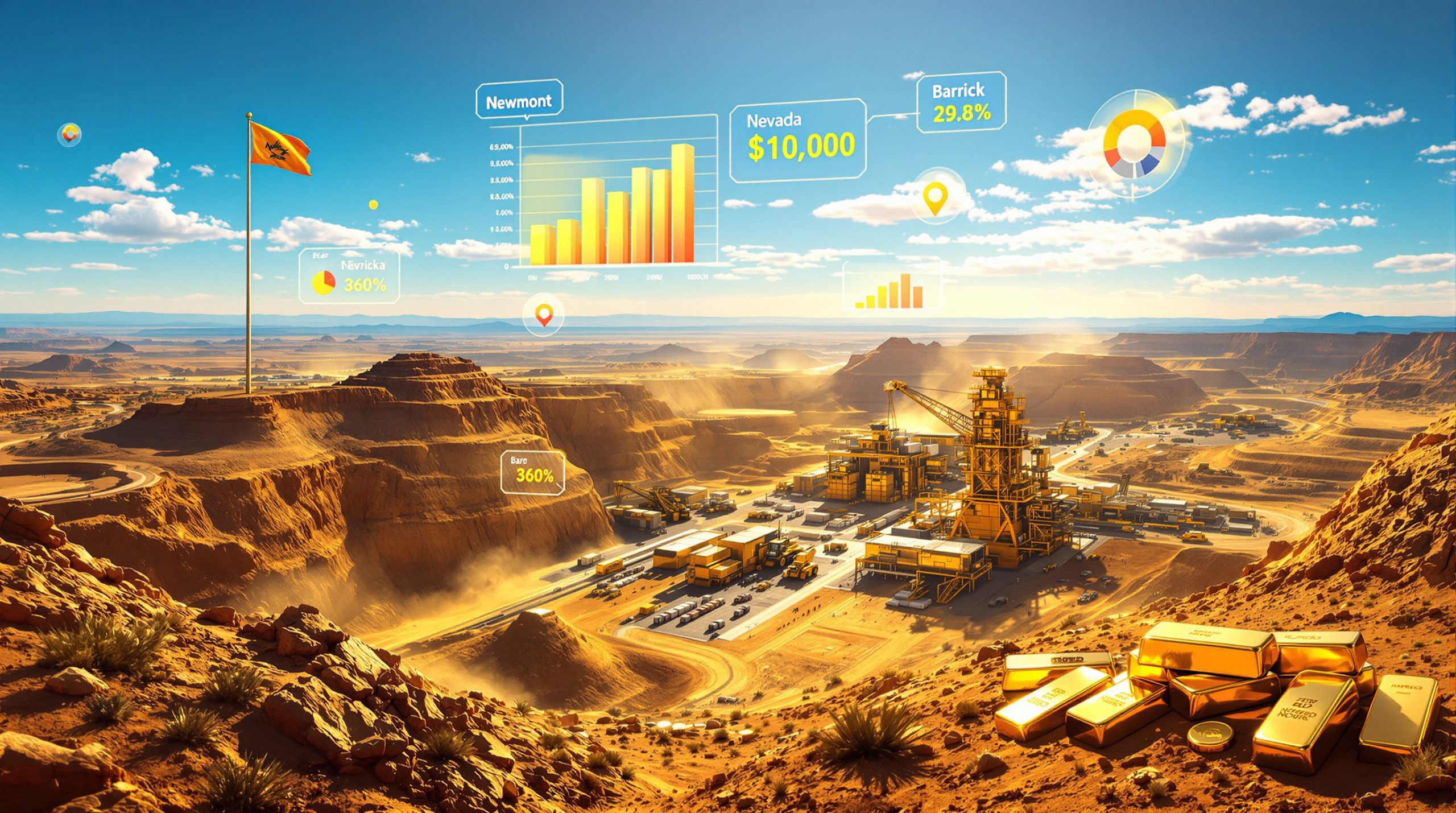What Caused the Recent Gold Price Decline?
The US-China Trade Deal Impact
Gold prices plummeted by $100 (3%) immediately after the announcement of a temporary US-China trade agreement, which reduced US tariffs on Chinese imports from 145% to 30% and Chinese duties on US goods from 125% to 10%. This 90-day pause in trade war impact ignited risk-on sentiment, prompting investors to shift capital from safe-haven assets like gold to equities. The Dow Jones Industrial Average surged by 400 points, while the Nasdaq gained 4%, reflecting renewed confidence in global trade stability.
The tariffs impact markets by alleviating supply chain constraints, particularly for industrial commodities, though gold's role as a hedge against economic uncertainty diminished temporarily.
Dollar Strength Correlation
The US dollar index (DXY) rose 1.16% to 101.76, its highest level in over a month, further pressuring dollar-denominated gold and silver prices drop. A stronger dollar increases the cost of gold for foreign investors, dampening demand. Historical data reaffirms gold's inverse relationship with the dollar, with a correlation coefficient of -0.87 over the past decade.
This dynamic was evident in the simultaneous dollar rally and gold sell-off, underscoring macroeconomic interdependence.
Technical Analysis Perspective
June gold futures breached critical support levels, with bulls losing their near-term technical advantage. Resistance now sits at $3,350, while immediate resistance is observed at $3,250. The breakdown below the 50-day moving average ($3,300) signaled bearish momentum, exacerbated by high trading volumes exceeding 300,000 contracts on the correction day.
Analysts at Kitco noted that gold's failure to hold above $3,300 suggests consolidation may precede further downside.
Why Did Silver Perform Differently?
Silver's Surprising Resilience
Silver declined only 0.37% to $32.87, compared to gold's 2.62% drop, narrowing the gold-to-silver ratio to 99.33:1. This divergence highlights silver's dual role as both a monetary and industrial metal. Reduced trade barriers bolstered expectations for industrial demand, particularly in electronics and solar panel manufacturing, which account for 60% of annual silver consumption.
The silver market squeeze demonstrates how these precious metals can respond differently to economic catalysts.
Industrial Demand Factors
The tariff rollbacks improved supply chain efficiency for silver-dependent sectors, with projected industrial demand growth of 8% in 2025. Silver's conductivity and antibacterial properties make it indispensable in 5G infrastructure and medical devices, sectors poised to benefit from eased US-China tensions.
The London Bullion Market Association (LBMA) forecasts a 500-ton deficit in silver supply by 2026, driven by green energy adoption, which could provide long-term price support despite short-term volatility.
Technical Support Levels
Silver maintained its position above the $32.50 support level, a psychological threshold tested twice in Q1 2025. Historical data shows that silver has held above $30 since late 2024, supported by central bank diversification strategies and retail investment inflows.
Analysts suggest that a sustained break above $33.50 could reignite bullish momentum, targeting $35 by mid-2025.
Is Gold Currently Overvalued?
Historical Price Perspective
Gold's recent peak of $3,488 (inflation-adjusted) approached its 1980 high of $3,500 in today's dollars. However, the rapid correction suggests market recognition of stretched valuations. The 14-day Relative Strength Index (RSI) for gold fell from 72 to 48, indicating diminished bullish sentiment.
When comparing current valuations with historical precedents, it's worth noting that gold spent less time above $3,000 in this cycle than in previous bull markets, suggesting the correction may be a healthy pause rather than the beginning of a bear market.
Factors Supporting Gold Prices
Central banks purchased 1,136 tons of gold in 2024, a 15% year-over-year increase, providing a price floor. Upcoming US CPI and PPI data will influence Federal Reserve rate decisions, with lower rates typically favoring non-yielding assets.
CME FedWatch Tool probabilities show a 68% chance of a 25-basis-point cut by September 2025, which could reignite interest in precious metals if realized.
Expert Market Opinions
Goldman Sachs analysts describe gold as "fairly valued" at $3,200–$3,400, citing equilibrium between ETF outflows and central bank demand. Conversely, JPMorgan warns of a potential 10% correction if inflation data surprises to the upside, testing the $3,000 support level.
"The current gold price consolidation is likely temporary, as the metal's fundamental role as a store of value remains intact amid persistent global economic uncertainties," noted a senior precious metals strategist at Bank of America.
How Might the Gold-to-Silver Ratio Evolve?
Historical Context of the Ratio
The ratio's drop below 100:1 marks a shift from its 2024 average of 110:1. Historically, the gold-to-silver ratio averaged 60:1 from 1900–2020, suggesting room for further compression. Silver's industrial applications position it to outperform gold in a trade-normalization scenario, as seen in 2010–2011 when the ratio fell from 65:1 to 32:1 during quantitative easing.
This historical context provides valuable perspective for investors considering relative value opportunities between the two metals.
Industrial vs. Monetary Demand
Silver's unique position is exemplified by its use in photovoltaic cells, which require 100 million ounces annually—20% of total supply. The International Energy Agency (IEA) projects solar installations to double by 2030, potentially elevating silver demand by 25%. Conversely, gold's lack of industrial utility makes it more sensitive to monetary policy shifts.
The dual demand drivers for silver—both as a precious metal and industrial commodity—create a distinct market dynamic that can lead to outperformance during periods of economic optimism.
Investment Implications
A narrowing ratio favors silver exposure. The iShares Silver Trust (SLV) saw inflows of $1.2 billion in Q1 2025, compared to $800 million outflows from the SPDR Gold Trust (GLD). Portfolio managers recommend a 60:40 gold-to-silver allocation to hedge against both inflation and industrial growth.
For investors seeking tactical allocation strategies, the current ratio presents an opportunity to rebalance precious metals holdings toward silver.
What Economic Indicators Will Impact Precious Metals Next?
Upcoming Data Releases
The US CPI release (May 13, 2025) is expected to show a 3.1% annual increase, down from 3.4% in April. Core PCE projections of 2.8% could reinforce Fed dovishness, supporting gold. Retail sales growth of 0.5% month-over-month may signal consumer resilience, favoring risk assets over havens.
The combination of these data points will help shape market expectations regarding monetary policy and, consequently, precious metals pricing in the near term.
Federal Reserve Policy Expectations
Futures markets price in 50 basis points of cuts by December 2025. Real yields on 10-year TIPS at 0.8% remain favorable for gold, historically inversely correlated at -0.75. Fed Chair Powell's Jackson Hole speech (August 2025) will be scrutinized for forward guidance.
The relationship between interest rates and gold prices remains critical, with lower rates reducing the opportunity cost of holding non-yielding assets.
Global Economic Considerations
The ECB's potential rate cuts in June 2025 may weaken the euro, indirectly strengthening the dollar and pressuring gold and silver prices drop. China's GDP growth forecast of 4.9% supports industrial metal demand, benefiting silver.
Additionally, geopolitical tensions in Eastern Europe and the Middle East continue to provide intermittent safe-haven demand, creating potential price floors during corrections.
Should Investors Buy the Dip in Precious Metals?
Strategic Considerations
Gold's 12-month volatility of 18% compares favorably to equities (22%), offering portfolio stabilization. Physical gold holdings by ETFs reached 3,500 tons in 2024, near record highs, signaling institutional confidence.
For long-term investors, price corrections historically present advantageous entry points, with previous dips of similar magnitude (3-5%) often followed by rebounds within 45-60 days.
Metal-Specific Opportunities
Silver's 2025 year-to-date gain of 12% outperforms gold's 6%, driven by industrial demand. The Silver Institute projects a 2025 average price of $35, representing 15% upside from current levels.
Recent gold highs analysis shows the relative value proposition of silver appears particularly compelling given its recent resilience and improved industrial demand outlook following trade tension reduction.
Risk Management Approach
Dollar-cost averaging mitigates timing risk, with historical data showing 20% higher returns versus lump-sum investments in volatile markets. Allocating 5–10% to precious metals balances inflation protection and liquidity needs.
Investment Strategy Note: Physical metal holdings provide additional security benefits during periods of market stress compared to paper derivatives, though storage and insurance costs should be factored into investment decisions.
FAQ About Recent Gold and Silver Price Movements
Will gold prices recover from this recent drop?
Recovery hinges on inflation trends and Fed policy. A CPI print below 3% could reignite bullish momentum toward $3,400. The latest gold price forecast suggests that gold's fundamental appeal as a hedge against currency debasement remains intact despite short-term volatility.
The metal's historical pattern suggests consolidation periods often precede further advances, particularly when supported by central bank purchasing and macroeconomic uncertainty.
Why did silver outperform gold during this correction?
Industrial demand optimism offset safe-haven outflows. Semiconductor manufacturers stockpiled 500 tons of silver in Q1 2025, anticipating relaxed trade barriers. This industrial component of silver demand creates a buffer during periods when monetary demand weakens.
Additionally, silver mine supply constraints persist, with primary silver producers facing declining ore grades and environmental permitting challenges.
What does the gold-to-silver ratio falling below 100:1 signify?
Historical precedent suggests mean reversion toward 70:1 is probable if manufacturing PMIs exceed 55. Ratio compression typically occurs during periods of economic expansion and monetary accommodation—conditions potentially emerging in the current environment.
Traders often use ratio extremes as signals for pair-trade opportunities between the two metals.
How do tariff reductions impact precious metals markets?
Lower tariffs reduce hedging demand for gold while boosting silver's industrial use. The 2025 trade deal could add $500 million annually to silver demand. Improved global trade conditions generally favor industrial commodities over pure monetary metals.
This dynamic explains the divergent performance between gold and silver following the US-China trade announcement.
Further Exploration
For detailed technical analysis, viewers are directed to Salivate Metal's YouTube channel, which provides daily market updates and stacking strategies for physical precious metals investors.
Investors should continue monitoring central bank policies, inflation metrics, and physical demand indicators from key markets like India and China for additional insights into potential price direction for gold and silver.
Looking to Identify the Next Major Mineral Discovery?
Stay ahead of the market with Discovery Alert's proprietary Discovery IQ model, which instantly notifies investors of significant ASX mineral discoveries and transforms complex data into actionable insights. Discover why historic mineral discoveries can generate substantial returns by visiting Discovery Alert's dedicated discoveries page and begin your 30-day free trial today.




